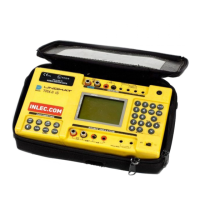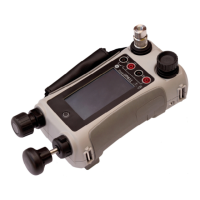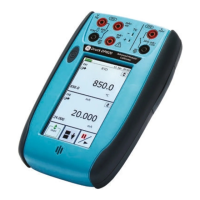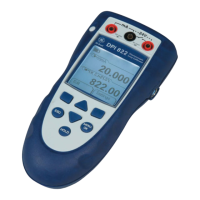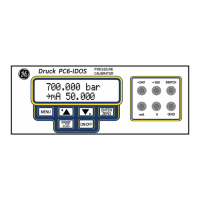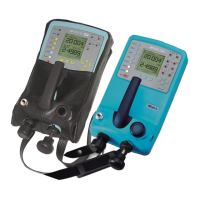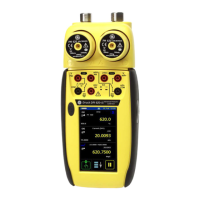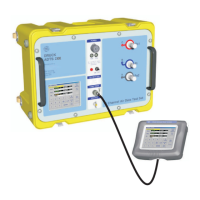Do you have a question about the GE Druck MCX-II and is the answer not in the manual?
Overview of the MCX-II calibrator's design and purpose.
Details the optional pressure module for measurements and calibration.
Explains features for automating calibration with memory cards and PC software.
Identifies and describes the various parts of the MCX-II calibrator (1-6).
Describes the four types of screen displays used in the MCX-II calibrator.
Explains the function of each key on the MCX-II calibrator's keypad.
Details how to install and use alkaline and rechargeable batteries.
Instructions for switching from alkaline to Ni-Cd rechargeable batteries.
Explains the process and requirements for recharging the calibrator's batteries.
Describes how to power the calibrator using an external AC adapter.
Explains how to configure the internal clock for date and time.
Details temperature units (Celsius/Fahrenheit) and scales (IPTS/ITS).
Instructions for switching between Celsius and Fahrenheit temperature units.
Instructions for selecting between IPTS 68 and ITS 90 temperature scales.
Explains how to change the calibrator's display language.
Describes how to set and manage the access code for protected menus.
Covers setting the backlight automatic shut-off mode.
Explains how to manually switch the LCD backlight ON or OFF.
Details how to adjust the screen contrast using a dedicated knob.
Describes the two ways the calibrator can be used: bench or portable.
Explains the keystroking feature for storing and recalling operations.
Instructions for clearing the stored keystroke memory.
General instructions on selecting input range and direct mode for measurement.
How to measure millivolts, including ranges and resolution.
How to measure volts, including ranges and resolution.
How to measure milliamps, including percentage indication and range.
How to measure resistance, including wiring methods and ranges.
How to measure frequency, including trigger levels and ranges.
Details the three available modes for pulse counting.
How to measure switch position changes and reset the reading.
How to check wiring continuity and measure switch resistance.
Recommends using compensation wires for accurate thermocouple measurements.
Explains using standard leads and the need for manual or remote temperature measurement.
How to measure temperatures using an optional Pt100 probe.
Details the required excitation current for RTD simulations.
Describes how readings can be presented in engineering units with a sign.
How to set up scaled readings using a linear relationship.
How to set up scaled readings for flow-related measurements.
General instructions for selecting output range and direct mode.
How to change the output reading without altering the actual terminal output.
How to change both output reading and actual output at the terminals.
How to ramp or enter new output values and handle range errors.
How to output signals between -10 mV and 100 mV with microvolt resolution.
How to output signals between zero and 12 Volts with microvolt resolution.
How to source current or simulate a 2-wire transmitter.
How to simulate resistance with different wiring methods and ranges.
How to output frequency signals, including voltage and amplitude settings.
How to output pulse signals between zero and 20 kHz with 1 Hz resolution.
How to output frequency signals in Pulses/Minute.
How to output frequency signals in Pulses/Hour.
How to set up and start pulse transmission with amplitude and Baud rate.
Details the required excitation current for RTD simulations.
Explains generating preset output levels in three different ways.
Describes programmable step settings for output levels.
Explains generating linear increasing or decreasing output signals over time.
How to start, stop, freeze, and restart a single ramp cycle.
How to start, stop, freeze, and restart continuous ramp cycling.
Details the fixed 24 VDC power supply available at the terminals.
Details the adjustable 0-24 VDC power supply available at the terminals.
Guides on setting up calibration for transmitters with scaled readings.
Procedures for checking and calibrating transmitters against ideal readings.
How to dial temperatures to simulate transmitters for control systems.
Steps to simulate transmitter output and view milliamps and temperature.
How to set up input/output conversion with programmable zero and span.
Steps for recalibrating the MCX-II using a fixed access code.
How to recalibrate the cold junction measurement system using an electronic thermometer.
Notes regarding calibration standards, test leads, power, and temperature settings.
Instructions for replacing the lithium battery to resolve clock problems.
Step-by-step guide on how to open and reassemble the calibrator's housing.
General troubleshooting steps when the MCX-II does not work properly.
Troubleshooting steps for when the unit fails to measure milliamps, focusing on fuses.
Troubleshooting steps for Ohms/RTD measurement failures, checking fuses.
Troubleshooting steps for the optional communicator, checking fuses.
Lists specifications for electrical measurements and outputs, including ranges and resolution.
Lists specifications for temperature measurements and simulations, including ranges and resolution.
Details the accuracy specifications for various functions over a one-year period.
Specifies the serial port settings for RS232 communication.
| Brand | GE |
|---|---|
| Model | Druck MCX-II |
| Category | Test Equipment |
| Language | English |


